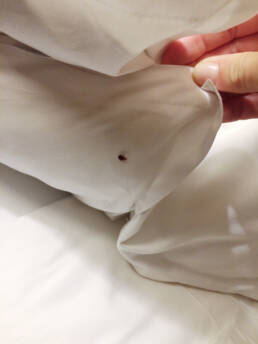As the summer draws to a close and children head back to school, there’s more to be concerned about than just books and backpacks. One unwanted hitchhiker coming home with your child is all it takes. These tiny pests are notorious for infesting schools, daycares and eventually your home. In this article, we’ll explore ways to protect your child and your home from getting bed bugs at school.
Understanding the Bed Bug Threat
Bed bugs (Cimex lectularius ) are small, red rust colored insects that feed on the blood of humans and animals. They are known for their stealthy behavior, often hiding in cracks, crevices, and furniture. Bed Bugs will feed anytime, but mostly at night. These pests are excellent hitchhikers and can easily travel from one location to another by attaching themselves to our belongings.
Prevention at Home
Education
The first step in preventing bed bugs is to educate your child about these pests. Teach them what bed bugs look like and how to recognize the signs of an infestation.
- Inspect and Encourage Cleanliness: Before allowing school items back into your home, inspect backpacks, clothing, and any other belongings. Encourage your child to report any new bites or inspect them for bites if they are younger.
- Regular Laundering: Wash your child’s clothes, backpack, and bedding regularly in hot water and dry them on high heat. Bed bugs can not swim but eggs have shown to survive a washing so dry on high heat.
- Isolate Infested Items: If you suspect any items are infested with bed bugs, isolate them in sealed plastic bags until they can be properly treated or discarded.
Prevention at School
- Backpack Awareness: Advise your child not to place their backpack or personal items on the floor or near upholstered furniture at school. Instead, encourage them to use designated hooks or storage areas.
- Locker Hygiene: Teach your child to keep their school locker clean and clutter-free, as bed bugs thrive in hidden, cluttered spaces.
- Regular Inspections: Encourage schools to conduct regular inspections and educate for bed bugs. Schools should have protocols in place for addressing any infestations promptly.
- Reporting: Instruct your child to immediately report any signs of bed bugs to school staff, such as itching or unusual bites. Early reporting can helps prevent the spread of infestation.
What to Do If Bed Bugs Are Detected
Despite your best efforts, bed bugs can still find their way into your home. If you detect them, take these steps:
- Isolate Infested Items and close off that bedroom: As mentioned earlier, isolate any infested items in sealed plastic bags to prevent the spread of bed bugs. Close off the bedroom to prevent further spreading.
- Contact a Heat Extermination Professional: Seek the services of a heat extermination professional who is experienced in bed bug removal. Heat is by far the best way to treat an infestation. Attempting to treat an infestation yourself can often make the problem worse.
- Inform School: Notify your child’s school about the issue to prevent further infestations and to help protect other students.
Conclusion
As your child embarks on another school year, remember that vigilance and education are key to preventing bed bug infestations. By taking proactive measures at home and promoting cleanliness and awareness at school, you can significantly reduce the risk of bed bugs disrupting your child’s back-to-school experience. With these precautions in place, you can ensure that your child focuses on learning and not on unwanted pests.
Contact us for your bed bug needs.

Ready for an expert opinion? Get in touch today!
We kill bed bugs in the infested space and surrounding walls by heating the space to a temperature of 135°F, killing all bed bugs and their eggs. If you have a bed bug problem, we have a solution. Exterminate bed bugs today with Hot Bugz. It’s safe and you get to keep your stuff. Call us today for a free consultation.
Like this article? Spread the word!
Related Posts
July 10, 2024
Banish Bed Bugs with Hot Bugz: Your Trusted Front Range Exterminator
Discover effective bed bug extermination with Hot Bugz, the premier Front Range bed bug…
December 8, 2023
Understanding What to Do When Bed Bug Treatments Don’t Work
Hot Bugz in Denver, CO offers comprehensive bed bug extermination services. From…
October 12, 2023
Comparing Heat Extermination Systems for Bed Bugs
This page offers actual explanations of the different heat treatment systems out there so…





